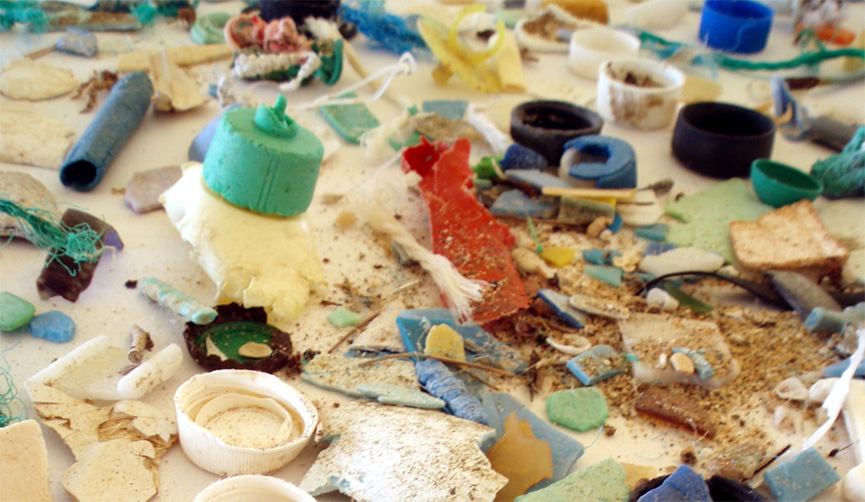Microplastics threaten oceans, marine life
UW Tacoma's Center for Urban Waters, led by Dr. Joel Baker, hopes to become a center for the study of a newly-emerging threat -- microplastic pollution.

"Cotton is the fabric of our lives," according to the tagline for Cotton Incorporated. But plastic is the substance that surrounds us from cradle to grave.
A century after the invention of plastic, it is hard to imagine a world without the ubiquitous consumer goods and packaging materials in our everyday lives. It's the baby's pacifier and bib. It's the nylon fibers woven into our clothes. It's the cell phone and laptop, iPod and television remote. It's the ballpoint pen and credit card, the grocery sack and "clamshell" food container.
Clearly, plastic in all its forms has brought humankind all manner of affordability, durability and convenience. However, this amazing, malleable substance made from oil, coal and natural gas has become a growing ecological threat.
Scientists began describing the problem of large pieces of plastic debris in the environment during the 1960s. By the 1970s, researchers were reporting plastic's effects on aquatic animals: Albatrosses ingest plastic bottle tops and balloons that block digestion and cause them to starve. Dolphins and turtles become entangled in fishing nets and drown.
Some 40 years later, a small group of ecologists, marine biologists and other scientists are pointing out an even greater threat — the widespread accumulation of small fragments of plastic. International scientists met at UW Tacoma this past fall to exchange research on this global pollutant. At stake are the world's oceans, which have become landfills for microscopic debris known as "microplastics."
"The world is seeing an exponential accumulation of plastic debris, from the very large to tiny fragmented pieces," says Dr. Joel Baker, professor and Port of Tacoma Chair of environmental science at UW Tacoma. "In the past four decades, we've come to understand the ecological issues of large flotsam, but we lack substantive evidence on consequences of the smallest plastic particles for marine ecosystems."
Baker is working with national and international partners to change that reality. In late 2009, he hopes to establish a microplastics research unit through the Center for Urban Waters. Baker serves as science director for the center, a new collaboration between UW Tacoma, the City of Tacoma and the Puget Sound Partnership.
Without definitive data it is difficult to rank microplastics' effects on the environment with other known pollutants, Baker points out. But the occurrence of tiny plastics in global oceans, and their potential for transporting other toxic compounds, may come to rival the worldwide prevalence of the pesticide DDT and its adverse effects on wildlife.
"Initial findings suggest that microplastics, like DDT and other 'persistent pollutants,' do not completely break down in the environment," Baker said. "What is more, plastic particles in the ocean appear to have the capacity to absorb and desorb organic chemicals."
Only a handful of the world's scientists study plastic's effects in marine environments. Nearly 20 years ago, Dr. Richard Thompson of the United Kingdom pioneered the investigation of microplastics and their pervasiveness in marine environments. The University of Plymouth marine ecologist has focused his efforts on decomposed plastic bits found along the shores of the northeast Atlantic Ocean. Plastic debris, large and small, is an abundant source of pollution in surface seawater.
Thompson studies microplastics present in the water column (the vertical section of sea or lake water from the bed to the surface), mixed in with seabed sediments and blended into sandy beaches.
"Oceans and shorelines overrun with microscopic plastics absolutely is a greater concern than 'macro-plastic,' " Thompson warns. "The widespread distribution of microplastics, combined with their size (five millimeters or less), make this debris highly available to more creatures that likely will ingest them."
International surveys investigating the amount of plastic debris in the oceans largely have focused on large detritus. The vast size of the oceans of the world make quantifying plastic particles the size of a pencil eraser or smaller a herculean challenge. Small plastic particles, in varying quantities, have been reported in habitats from the poles to the equator. One 20-year survey of surface seawater in the northeast Atlantic Ocean indicated a prevalence of about 400,000 particles of microplastics per square kilometer.
In the lab, Thompson's groundbreaking research has shown that tiny creatures such as barnacles, lugworms and mussels ingest plastic particles added to aquarium sediment. His research indicates that plastic pieces in the organisms' guts can migrate into their circulatory systems. Thompson also investigates the role microplastics may play in passing pollutants to marine organisms.
Thompson's research and various studies have suggested that plastic specks in the water column and sediment appear to absorb highly toxic and pervasive pollutants, such as PCBs (polychlorinated biphenyls) and pesticides such as DDT (once commonly used to eradicate agricultural and forest pests, and now banned in the United States and other countries). As one theory goes, if the oceans' smallest organisms are dining on plastics dosed up with toxins, then highly concentrated chemicals could possibly accumulate up the food chain.
"We just don't have enough research related to the ingestion of plastic particles by marine organisms and subsequent biological problems," says Thompson, who suggested animals' impaired ability to feed might be one effect.
"But the possibility of more and more creatures ingesting plastics that contain concentrated pollutants is real," he adds, "and quite disturbing."
Holly Bamford, director of the Marine Debris Program for the National Oceanic and Atmospheric Administration (NOAA), agrees that the toxic effect of plastic particles is a major concern that needs further investigation.
"There's some indication when the animals ingest chemically concentrated plastics, the particles not only do physical damage to the gut, but the pollutants may also desorb into the organism," she says. "Understanding the effects of contaminated microplastics to marine animals is critical to developing strategies to address this form of pollution."
NOAA sponsored last fall's three-day international conference on the UW Tacoma campus. Many of the best minds in the field of marine plastic debris came together for the first time to grapple with this emerging global problem. They left knowing that far more methodical research needs to be done in order to quantify microplastics' prevalence, identify sources of the debris and understand the full effects of this environmental threat.
"As microplastics go, we need to put energies into research — investigations of the kind that will allow the scientific community to draw solid conclusions," Baker says.
Ultimately, the issue becomes one of stopping plastic from getting into the environment in the first place. "Clearly, plastic products have many benefits," Thompson notes. "I am not anti-plastic, but I am convinced that society is not using plastic in the right way. Most plastic is manufactured into products or packaging that we discard in one year or less from the date of purchase. That's not sustainable."
Through the decades, affordable plastic consumer goods have played a pivotal role in raising our standard of living. Durable equipment and commodities composed of plastic — the vacuum cleaner, dishwasher and computer, for example — have enhanced our productivity. Plastic medical equipment — a simple syringe used for injecting vaccine or a defibrillator that restarts a heart — saves lives.
Thompson and others studying the effects of small plastics on the environment do not advocate for a world without plastic. However, the pioneering scientists do hope to make a robust case for living in a world where plastic, in all its forms, causes as little ecological degradation to the planet as possible.



